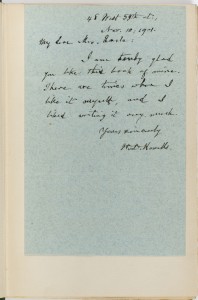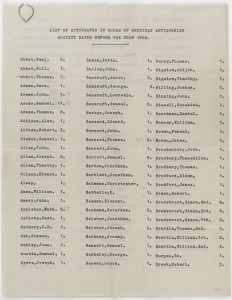Purely physical love for a book can sometimes be a book’s worst enemy. By fingering the books, prints, manuscripts, and newspapers in AAS collections, each reader and researcher contributes to the slow death of our materials. In his novel In the Name of the Rose, Umberto Eco writes that the saliva and dust left behind by such readers cause pages to lose their “vigor.” He writes:
“As an excess of sweetness makes the warrior flaccid and inept, this excess of possessive and curious love would make the book vulnerable to the disease destined to kill it.”

Thankfully, not every reader can lay claim to having owned and left a truly personal mark on an AAS book.
Charles L. Nichols, a Worcester physician and president of AAS from 1917 until his death in 1929, sought to document just one kind of personal mark on AAS books: the autograph. During the year following a 1922 report to the council on some of the great “association libraries” at AAS, including those of Isaiah Thomas, the Mathers, and Alice Morse Earle, Nichols documented the vast number of inscriptions in AAS association copies. His research resulted in a 1,500 card catalog file listing 598 names in pre-1800 AAS books. With the help of Tom Knoles, the Marcus A. McCorison Librarian, I was able to locate this file and compare the cards with Nichols’s notes for the project.

While most of the association copies remaining in AAS collections have been cataloged in the AAS online catalog, Nichols’s notes and writings still have relevance for the researcher studying association copies at AAS. Nichols’s notes are housed in AAS manuscripts [catalog record], and reveal the mind of a book-lover trying to make sense of early libraries and their owners, with lists of “curiosities,” “books of interest for a paper on AAS library + its autographs,” and “Mather library in AAS.” In the 1924 AAS Proceedings, Nichols states:
“These autographs and inscriptions reveal friendships, verify dates and localities, and bring to mind many interesting details of the lives and interests of the owners.”
Most especially significant, Nichols says, the Mather Family Library inscriptions reveal the “passage of…books from father to son through several generations.”
Through democratizing digital initiatives such as Readex’s Archive of Americana, EBSCO’s AAS Historical Periodicals Collection, and Gale’s Sabin Americana, AAS has made treasures from its archives readily available to students and scholars alike—while protecting and preserving the original documents. But personal interactions with AAS books remain possible for those who visit the AAS reading room, with clean hands and a pencil, of course.
Further Information:
The webpage for The Jay Fliegelman Library of Association Copies at Stanford University is still under construction. Fliegelman, past AAS Mellon Distinguished Scholar in Residence, was working on a history of association copies before his untimely death in 2007.
